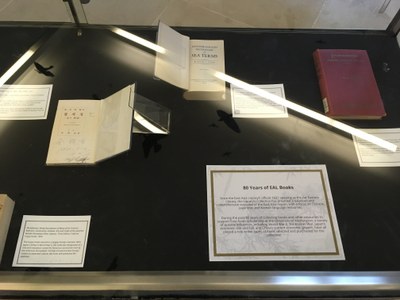80 Years of EAL Books
Since the East Asia Library’s official 1937 opening as the Far Eastern Library, the Library’s collection has provided a balanced and comprehensive overview of the East Asia region, with a focus on Chinese, Japanese, and Korean language resources.
During the past 80 years of collecting books and other resources to support East Asian scholarship at the University of Washington, a variety of outside influences, including World War II, the Korean War, Japan’s economic rise and fall, and China’s current economic growth, have all played a role in the types of items selected and purchased for the collection.
Bruce, J. Percy, E. D. Edwards, and Chien-Chun Shu. Chinese: Linguaphone Oriental Language Courses. Third edition. London: Linguaphone Institute, 1930. [link to library catalog]
In this 1930 Mandarin Chinese language learning resource,the printed textbook was originally accompanied by a gramophone record for learners to listen to the language’s different tones.
Ozaki, Chikara. Japanese-English Dictionary of Sea Terms. Berkeley: University of California Press, 1943. [link to library catalog]
Lieutenant-Commander Chikara Ozaki of the Japanese Naval General Staff compiled this dictionary. According to Sadao Asada’s 2013 history of the Imperial Japanese Navy and the United States, From Mahan to Pearl Harbor, Ozaki also translated the works of the influential naval strategist Alfred Thayer Mahan into Japanese.
We Japanese: Being Descriptions of Many of the Customs, Manners, Ceremonies, Festivals, Arts and Crafts of the Japanese Besides Numerous Other Subjects. Third Edition. Hakone: Fujiya Hotel, 1950. [link to library catalog]
The Fujiya Hotel catered to a largely foreign clientele. After Japan’s defeat in World War II, the hotel was designated as a rest-and-relaxation center for American servicemen during the American Occupation. To help introduce these foreign visitors to Japanese culture, the hotel self-published We Japanese.
張萬榮. 시집 : 詩와解說. 서울 : 春潮社, 1959. | Chang, Man-yong. Poetry of the Flowers. Seoul: Ch’unjosa, 1959. [link to library catalog]
In the early 1970s, the EAL began to develop and expand its Korean language collection. As one of the early Korean language librarians, Yoon-whan Choe, recalled: “At that time, there were relatively few academic libraries with Korean collections… Thus, we had a chance to develop a top-tier Korean collection.”
Hijirida, Kyoko, and Muneo Yoshikawa. Japanese Language and Culture for Business and Travel: A Text for Students and Travel Industry Managers. Honolulu: University of Hawaii Press, 1987. [link to library catalog]
By the late 1980s, during the success of the Japanese bubble economy, many Japanese had discovered international travel. As the book explains, international travel was included as one of the “‘Three V’s” popular at this time: “Villas, Visiting nationally, and obtaining Visa to visit other countries” (ix).
经理人汉语 : 语音篇 = Chinese for Managers. Beijing: Foreign Language Teaching and Research Press, 2005. [link to library catalog (volume 1)]
赢在中国 : 商务汉语系列教程 = Winning in Chinese: Business Chinese. Beijing: Beijing yu yan da xue chu ban she, 2010. [CD-Rom]. [link to library catalog]
With the international expansion and development of the Chinese economy in the 2000s, more and more resources have been published for foreigners aspiring to work with Chinese companies.
윤 동주. 시 를 새기다. 경기도 파주시 : 활판 인쇄 학교, 2016. | Yun, Tong-ju. Korean Poems Printed by Letterpress. Translated by Brother Anthony of Taizé. Kyonggi-do P’aju-si: Hwalp’an iIswae Hakkyo, 2016. [link to library catalog]
Korean language librarian Yoon-whan Choe began purchasing privately-published Korean poetry books for the EAL’s collection in 1969. This volume is a more recent addition to the collection.
 Facebook
Facebook
